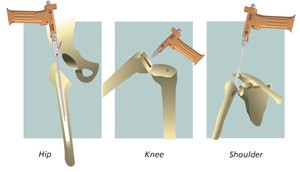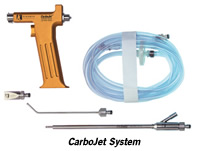
CarboJet® CO2 Bone Preparation System
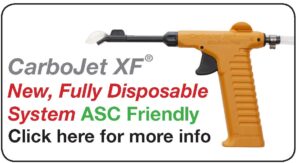 Why Use CarboJet to Clean Bone?
Why Use CarboJet to Clean Bone?
Advantages of a cleaner & drier bone bed:
• Removes lipids / fatty marrow elements from the bone bed to improve bond strength
• Facilitates Tourniquetless TKA, which has been shown to reduce post-op pain and opioid use
• Increases Cement Penetration Into the Bone Bed, even in tourniquetless TKA
• Increases Bone-Cement Interface Strength
• Reduces Opportunity for Micro-Emboli
• Removes Immunogenic Elements from Osteochondral Allografts (OCA).
Aseptic loosening is now recognized as the predominant failure mode in primary knee arthroplasty. A recent study of 938 primary knees found that aseptic loosening was the most common mechanism of failure, accounting for 28% of all failures. In UKA, aseptic loosening accounted for more than 60% of failures. These data underscore the importance of achieving optimal cement fixation via meticulous cleaning and drying of the bone bed.
CarboJet’s CO2 gas jet quickly and thoroughly cleans and dries the bone bed by bringing blood, saline and, most importantly, lipids/fatty marrow elements to the surface where they are easily collected and removed. Cleaning and drying with CarboJet takes no more time than is typically required for drying with lap sponges. The superior cleaning achieved with CarboJet improves cement penetration depth thus offering the potential for a reduction in bone cement interface stress and increased cement mantle toughness. Increased bone-cement interface strength is the result.
How does it work?
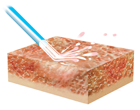
Saline lavage is effective at removing gross debris, but fluid mixing in the interstices of bone prevents thorough cleaning.
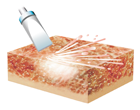
A compressed gas jet effectively displaces fluid and fluid- suspended debris, thereby cleaning and drying porous structures.
Why CO2?
Compressed CO2 gas has been employed as an insufflation medium in laparoscopic procedures for decades and is readily available at all hospitals.
Nozzles are available for use in TKA, UKA, THA, TSA and other cemented reconstructive applications.
In clinical use since 1993, CarboJet has been shown to be safe and effective in multiple clinical studies and in tens of thousands of joint reconstructive procedures. We invite you to trial CarboJet to see the benefits for yourself and and to discover why so many surgeons are making CarboJet a standard part of their cement technique.
Role of CarboJet in Tourniquetless
TKA and Opioid Use
Meneghini et al showed that tourniquet-less TKA decreases pain and opioid consumption in females. CarboJet was used to maximize cement interdigitation – an essential component of the tourniquetless TKA technique. The ability to reduce opioid consumption using this technique is significant given the national crisis in opioid addiction and the need to develop surgical protocols that result in reduced patient pain. A subsequent study confirmed that the use of CarboJet resulted in increased cement penetration in Tourniquetless TKA.
Surgeon Testimonials
“I would not be able perform a Tourniquetless TKA without the aid of CarboJet to remove blood, saline and lipids from on and below the bone surface. This technique ensures my patients have an optimal outcome – in the short term with reduced post-op pain, and in the long term with less risk of aseptic loosening.”
David Camarata, MD, Steward Orthopedic & Sports Medicine Center, Scottsdale, AZ, USA
“We find the CarboJet to be very helpful in our robotic partial knee replacement surgeries.”
Paul Gilbert, MD, Assistant Professor of Clinical Orthopaedic Surgery at the Keck School of Medicine School of USC, Los Angeles, CA, USA
“CarboJet provides my patients with a much cleaner, drier bone bed allowing for better cement penetration and hence a better mechanical interface between bone and implant for secure long-term fixation.”
Richard “Dickey” Jones, MD, Orthopedic Specialists, Dallas, TX, USA
“Over the past year I’ve stopped using a tourniquet when performing total knee replacement (TKR). My decision to stop was based on a mounting body of evidence, and in my hands and with my technique, the risks do not out weight the benefits. While my initial interest to stop using a tourniquet was to lessen post-operative pain and improve the experience; I see patients getting well even faster and going home from the hospital sooner with less pain and swelling, and less need for prolonged formal therapy than ever before. With less pain, there is less need for strong pain meds (narcotics) and thankfully patients no longer complain that their upper thigh is sore. My technique of performing TKR incorporates CarboJet in preparation for final cementing.” (as quoted here)
William A. Leone, MD, – Leone Center for Orthopedic Care, Fort Lauderdale, FL, USA
“The use of a carbon dioxide gas spray and cement pressurization has essentially eliminated the problem of postoperative radiolucent lines.” (as quoted here)
Frederick A. Matsen III, MD, University of Washington Medical Center, Seattle, WA
“Excellent cement mantle thickness and consistency, with fewer radiolucent lines, has been observed with the use of CarboJet combined with simple bulb syringe saline lavage in my UKA cases.”
Dennis McGee, MD, Saint Alphonsus Medical Group, Boise, ID, USA
“I have been performing all my cemented total knee replacements without any use of the tourniquet since January of 2016 and have used CarboJet on all of these cases. I believe tourniquetless TKA will inevitably become the ‘standard of care’ for all routine knee arthroplasty procedures.”
R. Michael Meneghini, MD, Indianapolis, IN, USA
“I use it on Uni Knees. We often get a lot of bone bleeding – even with a tourniquet during cementation. The CarboJet dries the bone superbly for implantation. Outstanding addition to my surgical technique!!”
Airell Nygaard, MD, Yosemite Joint Replacement, Sonora, CA, USA
“I have made gas jet lavage with CarboJet the critical last step in bone preparation in all my cemented arthroplasty cases. The removal of additional marrow elements that could otherwise form embolic debris during cement pressurization is important to patient safety.”
H.M. “Mac” Reynolds, MD, Oakland, California, In Memoriam

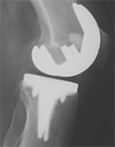 CarboJet bone preparation provides the opportunity for complete “whiteout” of the cement mantle in the hip and increased cement penetration under the tibial component in the knee. (X-rays courtesy of H.M. Reynolds, Oakland, CA, In Memoriam)
CarboJet bone preparation provides the opportunity for complete “whiteout” of the cement mantle in the hip and increased cement penetration under the tibial component in the knee. (X-rays courtesy of H.M. Reynolds, Oakland, CA, In Memoriam)
“I use CarboJet with no tourniquet for the majority of my cemented TKAs. While the bone does not appear quite as dry as when using a tourniquet, CarboJet has a big impact. Notably – I no longer see the expulsion of fat and blood when impacting as I did before using CarboJet. “
Jake Stanfield, MD, Northwest Orthopaedic and Sports Medicine, Richland, WA
“I’ve eliminated the tourniquet in nearly all my cemented knees and it has been a game changer for my patients – less early postop pain and quadriceps dysfunction. CarboJet is key for me in addressing the bone preparation challenges with tourniquetless TKA. With CarboJet and some intramedullary suction, my cement mantles are better than when I used a tourniquet.”
Michael Decker, MD, MSc, Medical College of Wisconsin, Milwaukee, WI
Videos
Lipids and Fluids Debris Removal in TKA with and without Tourniquet
A New Approach for the Cleaning and Preparation of Bony Surfaces in Cemented Total Joint Arthroplasty | Video Journal of Orthopaedics (vjortho.com)
H.M. Reynolds, MD
Eliminating the Tourniquet in TKA: Why and How I do it
R. Michael Meneghini, M.D.
Reducing Opiate Use: The Tourniquetless TKA
R. Michael Meneghini, M.D.
Maximizing Cement Interdigitation During TKA
Richard E. Jones, M.D.
TKA Sans Tourniquet
Richard “Dickey” Jones, M.D. – CCJR Sept. 2014
En Español – Em Português
VacuJet® Self-Cleaning Suction
by James B. Stiehl, M.D
Osteochondral Allografts: Pearls to Maximize Biologic Healing and Clinical Success
by Brian Cole, M.D
Patents
U.S. Patent 8,100,851 and 8,721,595. Japan Patent 5,735,524. Australia Patent 2021301112. Additional U.S. and International Patents Pending

